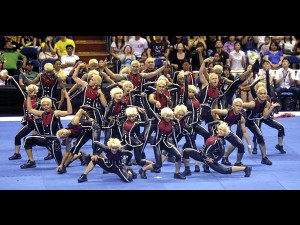
Just a few moments ago, the Big Dome was an explosion of school colors and the roar of practiced cheers.
Now the frenzy is over and everything is muted. Cheer dancers form quiet circles, clasping hands with heads bowed as they await their collective fate.
There are always two faces at the annual Cheerdance Competition of the University Athletic Association of the Philippines (UAAP). At every competition, two stories unfold – a story of triumph and a story of heartbreak.
This year, the UP Pep Squad soared to seventh heaven. Their closest rival, the UST Salinggawi Dance Troupe (SDT) slid down to fourth place.
The DLSU Animo Squad broke a 13-year drought and propelled themselves to a second place finish. The FEU Cheering Squad members disappointed themselves with a third place win.
The competition was over in three hours. But each team’s six-minute routine will be recalled, replayed and remembered – in glory or infamy – countless times on YouTube and other social media sites.
This is the culture of cheerleading in the UAAP. The show is held for a day but die-hard fans and the dancers live it for the rest of the year. They have the rivalry between UP Pep and the UST SDT to thank for that.
The first UAAP cheering competition was held on Aug. 13, 1994, a mere sideshow to the basketball games. All the teams were newbies then, except for two established squads: the Ateneo Blue Babble Battalion and the De La Salle University Pep Squad.
UST didn’t even have cheerleaders then, so they pulled out some dancers from the university’s Salinggawi Dance Troupe (SDT), specializing in folk dancing.
But Salinggawi (meaning “Salin ng mga dating Gawi”) won the championship that year.
The UP Pep Squad, under the direction of Coach Lalaine “Lala” Pereña, earned its first title in 1999, and won three in a row.
UST wrested back the title in 2002, enlisting former dancer Ryan Silva as the troupe’s choreographer, leading to a still unmatched record of five titles.
Each team’s yearly performance is either a stroke of genius or a touch of folly on the part of the coach.
Pereña is said to prepare for a routine two years before the actual competition. FEU Coach Jacquiline Alolor brainstorms with the dancers after a competition and finalizes the squad’s theme before summer.
Silva has no fixed routine for drawing up the team’s concept.
In the 2000s, SDT pushed the envelope with tosses, lifts and pyramids. The squad is also said to be the first to use canned music and to get rid of the traditional pompoms.
UP claims to have been the first to adopt an overall theme in the dancers’ routine, and introduced moves that other squads would replicate the following years.
It’s difficult to pinpoint exactly when the rivalry flared to fever pitch.
UP’s basketball team’s recent dismal performance gave the Pep impetus to try harder, as a cheerdance win would give the UP community something to cheer about.
SDT has enthralled its fans since its first win in 1994, a golden year because the Growling Tigers were also excelling. Even when the Tigers faltered, UST’s cheerdancers had been consistent.
The rivalry parallels Philippine elections because neither camp would concede defeat. Judges are questioned and closed-door meetings before winners are announced are met with raised eyebrows.
The aftermath was war in forums and blogs, with the dancers attacked on anything from looks to performance.
Unsurprisingly, loyal fans are as rabid, camping out at the ticket booths.
It is ironic that the rivals mirror each other off-season. They have their own set of woes.
Budget is its main concern, according to the UP Pep’s coach. While the university provides the competition uniforms, Pereña says most of their expenses are covered by prize winnings and fund-raising concerts, with dancers sometimes shelling out their own money for what they need, like the halftime shirt that Captain Kae Madrigal says cost him P500.
UST shoulders the cost of uniforms and shoes of the SDT squad, with fund-raising events held to augment the budget. Still, SDT president Adams Aaron Bernabe had to look for a food sponsor. The SDT also faces an identity crisis. Known outside the campus as a cheerleading squad, the SDT is still considered a dance troupe inside UST, with the added expectation for them to organize a dance competition in-campus. This, says the team, leaves them barely a month to focus on their cheer competition routine.
“We also don’t know if they consider us as part of the athletics or part of the arts,” says Silva. From the Institute of Physical Education and Athletics, SDT is now under the Office of Student Affairs.
The squads take the competition seriously. Two weeks before, UP Pep members try to eat light and healthy.
SDT follows the 3Ds: diet, discipline and dedication. The diet part isn’t easy to comply with, what with teachers, alumni, and priests showering them with bags of chocolates before the competition. “The sugar rush will make us hyper,” explains vice president Anna Camille Cruz.
The dancers know that they are living the time of their life, and their cheerdance stint can change it.
UP Pep Inad Dionillio graduated with a Civil Engineering degree three years ago but still performs every once in a while. He currently coaches Poveda High School in their stunts part time.
“I’ve gotten over my shyness. I’ve headed a team composed of dancers and drummers of up to 70 people,” he says. “I’ve learned to appreciate different types of personalities, different work styles, and various quirks that really made me realize how different we all are.”
That and knowing that they will always be a source of school pride.
Photographs by August de la Cruz